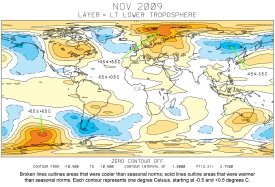Dec 15 2009
The strong signature of an El Niño Pacific Ocean warming event showed up as the warmest November in 30 years — and not just by a little bit. November 2009 was a full 0.1 C (0.18 degrees Fahrenheit) warmer than November 2005, the second warmest November in the 31-year satellite record.

Global climate trend since Nov. 16, 1978: +0.13 C per decade
November temperatures (preliminary)
Global composite temp.: +0.50 C (about 0.90 degrees Fahrenheit) above 20-year average for November.
Northern Hemisphere: +0.42 C (about 0.76 degrees Fahrenheit) above 20-year average for November.
Southern Hemisphere: +0.58 C (about 1.04 degrees Fahrenheit) above 20-year average for November.
October temperatures (revised):
Global Composite: +0.29 C above 20-year average
Northern Hemisphere: +0.27 C above 20-year average
Southern Hemisphere: +0.30 C above 20-year average
(All temperature variations are based on a 20-year average (1979-1998) for the month reported.)
Notes on data released December 7, 2009:
The strong signature of an El Niño Pacific Ocean warming event showed up as the warmest November in 30 years — and not just by a little bit, according to Dr. John Christy, professor of atmospheric science and director of the Earth System Science Center at The University of Alabama in Huntsville. November 2009 was a full 0.1 C (0.18 degrees Fahrenheit) warmer than November 2005, the second warmest November in the 31-year satellite record.
Warmest Novembers (Global)
Year Anomaly
2009 +0.5 C
2005 +0.4 C
2002 +0.35 C
1990 +0.32 C
2003 +0.32 C
The warming during November was strongest from the tropics to the South Pole. November temperatures north of the tropics were not generally unusually hot: The northern sub-tropic November was only the ninth warmest, while the Arctic saw its 13th warmest November. By comparison, the tropics and Antarctic saw their second warmest November, while the southern temperate zone and the Southern Hemisphere both saw record high temperatures compared to seasonal norms.
Warmest Novembers (SH)
Year Anomaly
2009 +0.57 C
2002 +0.38 C
1990 +0.34 C
2005 +0.32 C
1997 +0.28 C
Warmest Novembers
(U.S., 48 contiguous states)
Year Anomaly
1999 +2.51 C
2001 +1.91 C
1990 +1.72 C
2009 +1.45 C
1998 +1.07 C
Color maps of local temperature anomalies may soon be available on-line at:
As part of an ongoing joint project between The University of Alabama in Huntsville, NOAA and NASA, Christy and Dr. Roy Spencer, a principal research scientist in the ESSC, use data gathered by microwave sounding units on NOAA and NASA satellites to get accurate temperature readings for almost all regions of the Earth. This includes remote desert, ocean and rain forest areas for which reliable climate data are not otherwise available.
The satellite-based instruments measure the temperature of the atmosphere from the surface up to an altitude of about eight kilometers above sea level. Once the monthly temperature data is collected and processed, it is placed in a "public" computer file for immediate access by atmospheric scientists in the U.S. and abroad.
Neither Spencer nor Christy receives any research support or funding from oil, coal or industrial companies or organizations, or from any private or special interest groups. All of their climate research funding comes from state and federal grants or contracts.